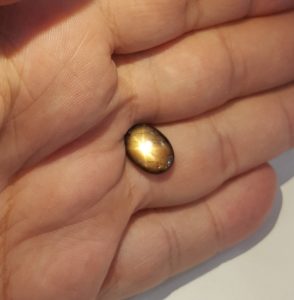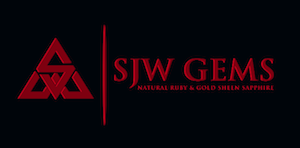I will not be posting a chart for the first half of 2020. Because the global lock down situation I have not been able to gather enough data and I would rather not rely on too few datapoints.
Nevertheless, observing web based prices across major online sales and auction sites, I can make the following comments:
- There is very little Commercial to Good/Very Good grade material being offered. In the Commercial grade, most are from old ads that have not changed for some years.
- Offering of brown and black star sapphire masquerading as Gold Sheen sapphire have declined.
- Fine and Exceptional grades are being offered at $500 to $1,000 per carat.
- Greenish hues of Gold Sheen Sapphire have been increasing in popularity with much yellowish green and blueish green material being offered.

I will also point out that the Wikipedia article on Gold Sheen Sapphire remains inaccurate, for example this quote from the Wikipedia page: “Natural star sapphire is also known as black star sapphire”. The article also defames several well respected gem labs, with the deliberately misleading libelous claim: “Goldsheen sapphire has been tested and confirmed in lab reports as ‘natural star sapphire’ by GIA, GIT, GRS, AIGS, Tokio gem labs and Lotus”. To imply that Gold Sheen Sapphire or black star sapphire is the same as other star sapphire is simply wrong. And to then imply that, as a result, Gold Sheen Sapphire is therefore the same as as any natural star sapphire beggars belief.
The problem with that may not be obvious to people not familiar with star sapphire and the difference between varieties. So I will spell it out.
- Star sapphire can come in any colour, except red (in which case it is called star ruby).
- Black star sapphire is a particular variety of star sapphire, mostly originating from mines in Thailand and Australia.
- Gold Sheen Sapphire has a very specific composition that, so far, has only been found in one source from a single mine.
- Any sapphire or ruby that is mined and not manufactured in a lab is called ‘natural corundum’. Sapphire or ruby that is manufactured or made in a lab is called ‘synthetic corundum’.
- In gemological classification there is no such term as ‘natural sapphire’, it is termed ‘natural’ or ‘synthetic’ corundum. This may seem like a trivial differentiation, but it is important in laboratory identification of gemstones, and no gemologist would make the mistake of misclassification. Certainly no reputable gem lab (and the labs cited are the most reputable in the world) would or has ever reported that Gold Sheen Sapphire is ‘natural star sapphire’.
- Having the same elements chemicals present in two different gemstones does not make the two gemstones the same. For example, Labradorite and Sunstone are both feldspars and have the same basic composition, but Sunstone has advernturesence that Labradorite lacks. So too with Gold Sheen Sapphire and other sapphire varieties, the same elements are present but Gold Sheen Sapphire was determined to be a different variety of corundum because of its unique characteristics that are not shared by any other type of corundum.
- The Wikipedia article author somehow draws the conclusion that:
a. Natural star sapphire is the same as black star sapphire.
b. Because Gold Sheen Sapphire contains many of the same elements as other corundum varieties, it is therefore the same as black star sapphire.
c. That the articles cited actually say this (whereas in fact they say the opposite).
The reason this is important is that black star sapphire is relatively common. Gold Sheen Sapphire is rare. Gold Sheen Sapphire also commands a significantly higher price.
Claiming black star sapphire is the same as Gold Sheen Sapphire is done to defraud the buyer into paying a higher price for black star sapphire than they otherwise would. Or to trick a seller into accepting less for Gold Sheen Sapphire than it is worth in the market. In my example above, Labradorite sells for tens of dollars per carat, while Sunstone sells for hundreds of dollars per carat. The same is true for black star sapphire at $10-$50 per ct versus Gold Sheen Sapphire at $100-$1000+ per ct.
It is sad to see Wikipedia being misused this way to promote such misinformation. It is also of note that revisions to remove the incorrect information is reverted within minutes or hours, and always by an anonymous editor or bogus account. I personally find it poor reflection on Wikipedia’s editorial policy that make it time consuming and nigh impossible to correct blatantly nonfactual and misleading information.
For factual information on Gold Sheen Sapphire, I have published this article on the difference between Gold Sheen and other corundum varieties. Also this ‘Wikipedia ready’ page to replace the current Wikipedia article with verifiable and gemologically accurate information – Gold Sheen Sapphire Article-for-Wikipedia.
For more information on grading Gold Sheen Sapphire, this is the grading system developed by Tanzim and me – Gold Sheen Sapphire Grading.
